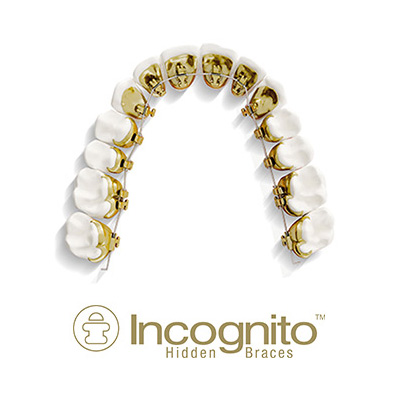Lingual Braces vs. Invisalign: Which Is Better?

As modern technology has advanced, so have the opportunities to straighten teeth in a multitude of ways. Because of this, lingual braces and Invisalign have become popular options for orthodontic care due to their discretion and near-invisibility. While lingual braces have brackets and wires attached to the backside of the teeth, Invisalign offers braces-free care with the use of clear, removable aligners. Both options have their pros and cons, and should be chosen upon an individual’s needs and wants. Find out whether lingual braces or Invisalign is the best option for your orthodontic needs with this guide!
What Are Lingual Braces?
Millions of teenagers and adults have braces put on each year, and most pick the traditional metal braces that we’re all so used to seeing. However, traditional braces can be bulky, annoying and embarrassing for teenagers and adults alike, and many patients feel like they’re distracting. Lingual braces are another option for patients who prefer invisible treatment over big, bulky braces, plus they can achieve the same straight, beautiful teeth that other treatments provide. Instead of wearing braces on the outside of teeth, lingual braces attach the brackets and wires to the backside (lingual side) of teeth for an inconspicuous and nearly-invisible treatment. Other than aesthetic concerns, patients opt in for lingual braces as they make it easier to play wind instruments, such as the flute or tuba, and they’re more functional for athletes that play contact sports. However, not every orthodontic office offers lingual braces; orthodontists have to complete specialized training to be able to install lingual braces, so you’ll have to do your research to find out who in your area is qualified to perform treatment.
Additionally, lingual braces can take longer to get used to since they’re on the backside of your teeth, close to your tongue. They can make swallowing more difficult as the tongue can’t thrust between your teeth as easily as it could before. Patients also have to have long enough teeth to provide enough room for the braces to be glued onto them, so children and those with small teeth typically don’t qualify for this type of treatment. Lastly, treatment time is usually longer with lingual braces than traditional braces. The entire process depends on your orthodontist and how well you take care of your teeth during treatment, so treatment time varies from patient to patient.
How Invisalign Works
Another option for patients who prefer invisible orthodontic care is Invisalign, which uses clear, removable aligners to fix malocclusion over a period of several months or years. Some patients highly dislike the look of metal braces, lingual or not, and Invisalign offers them the care they need without having to sacrifice their confidence at work or social events. Many enjoy Invisalign because its unique treatment allows them to remove their orthodontic device during eating, drinking, flossing and brushing, making these daily activities much more manageable. They let you eat all of your favorite foods, you can’t break a wire or bracket, oral hygiene isn’t hindered and they’re virtually invisible.
Wearing Invisalign retainers does take time, effort and patience, however. One aligner is worn for one to two weeks before replacing it with the next one in line. You’ll have a checkup every six to eight weeks to monitor your teeth and receive a new batch of aligners to wear for the next several weeks. During this time, Invisalign aligners need to be worn for 20-22 hours of the day, which is a huge commitment for busy people. Aligners also need to be carefully washed and cleaned with a toothbrush each night to keep bacteria from growing. Since they’re removable, Invisalign aligners can be easily lost, misplaced or broken by a fall or child, so extreme care will be necessary to keep them intact.
Making A Choice
Both lingual braces and Invisalign are viable options for patients who want orthodontic care that is undetectable and discreet, but whichever you choose is up to you and your orthodontic needs. The first step that you’ll need to take is to visit with your orthodontist for an evaluation of your teeth and to discuss which of the two would work best for your wants and needs, plus the orthodontist’s recommendation. Remember that while Invisalign is a great option for those who want to take their orthodontic care into their own hands, it requires extreme responsibility and care for the aligners you’ll be using. Lingual braces, on the other hand, will always remain in your mouth, so you won’t need to worry about losing anything like you do with Invisalign, but flossing and brushing can be more difficult as you’ll have to do it all from the backside of your teeth. Your choice should be based on what you are willing and not willing to do during treatment, so do your research on both options to be fully informed on what to expect.
Schedule Your Consultation
To be evaluated for lingual braces or Invisalign, call Belmar Orthodontics at (303) 225-9016 to schedule a consultation. Our team is qualified and experienced at installing both lingual braces and Invisalign, plus we can give you extra tips on how to keep your teeth brilliant and healthy during treatment. Call today to start your journey to a more beautiful smile!
Braces: How Are They Made?

You may wonder what the differences are between metal, ceramic, and lingual braces and how they compare to Invisalign treatment. All are a bit different and they are both made and worn differently. Braces are made from various materials and designed specifically for your mouth.
Metal Braces and Your Teeth
You’ve likely seen someone wearing metal braces and you know that they make your teeth straighter. But how? It takes a bit of science and the right orthodontic appliance to make that beautiful smile happen. With the most common type of braces—metal braces—you have a stainless steel material that is shaped into specific orthodontic parts that will all go together in your mouth. Often those parts are molded and shaped in a special lab that then ships those parts to orthodontists.
Labs will even do custom-made brackets and wires for patients when the need arises. However, most braces have a specific design like metal braces do. Metal braces have several parts that include:
- Brackets: These stainless steel pieces are those little squares bonded to the middle of each tooth. We use a special bonding glue that will stay on your teeth for the entire duration of your treatment, but will come off easily with the right orthodontic material. Your brackets are small anchors that hold a wire in place. They will have tiny rubber elastics placed around them to protect your teeth and prevent stuck food.
- Archwire: This metal wire will pass through the brackets on each tooth, all the way to the back of your mouth. Many patients have a bracket that wraps around the back molar that stabilizes this archwire. The wire will follow the curve of your jaws in an elongated have circle. When a thicker archwire is placed or when this archwire is adjusted, it can help move the teeth into place because of the force placed on the brackets.
- Ligature Elastics: These are the rubber elastics we mentioned. The elastics are what keep the archwire sturdy so it can straighten your teeth.
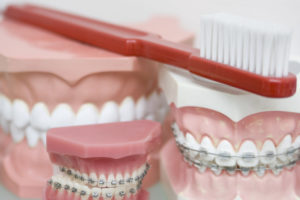
How Teeth Straighten
Your archwire will be adjusted very slightly at your orthodontic appointments every 4-6 weeks. That slight adjustment may seem very small, but it’s what your mouth needs to make a true, straightening change. The appliance is not the only thing changing your teeth into a straighter position. Your teeth are the hardest substance in the body and can even be harder than many metals. Straightening them would seem very difficult, when it’s not. It simply takes time.
Your teeth can take a ton of force from chewing, biting, eating, talking and other actions because they are rooted into your jawbone. However, the jawbone is much weaker than the teeth are. So why doesn’t your jawbone get breaks in it when you chew hard things? You have something called the periodontic ligament that is around every tooth root as it goes into your jaw bone. All those ligaments are shock absorbers for your jaws when you chew, minimizing the force your jawbones take. These are key to straightening the teeth.
When orthodontic appliances are on the teeth, they will apply a very slight pressure to your teeth and to the periodontic ligaments that surround them. When that pressure is constantly there, your body will produce acids in the jawbone area that will break down tiny parts around the teeth. With new space created, the teeth can shift. Your body will naturally deposit more minerals in areas that have changed to strengthen the jawbone once more. Over time, your jaw is literally breaking itself down on a microscopic level and then rebuilding itself. That is why orthodontic treatment takes months. However, the result is worth it.
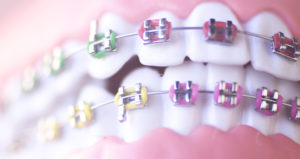
Ceramic and Lingual Braces
Ceramic and lingual braces are very similar to traditional metal braces, but are made a bit differently. Lingual braces are also a metal braces type, and most types are made from stainless steel in a lab. There can be other types of metal used or a combination of metals. These braces will have brackets and wires just like traditional metal braces, except that they will be placed on the back of a patient’s teeth.
Because of placement, children are not usually candidates for lingual braces because of the size of the teeth. Dental impressions of the back of the teeth are made so that metal coverings can be made for the tooth backs, which is a bit different than traditional metal braces. More anchoring is needed with lingual braces, and this is how it is done. The metal material will cover the entire tooth back with a bracket in the center of the tooth, and each is placed individually when a patient gets their appliance. The archwire works the same as other braces.
Ceramic braces are very similar to metal braces in their design and how they work. However, they are made from ceramic material, which is naturally white already. This makes the braces blend in with the teeth more, and the metal can even be frosted to blend in with whiter teeth.
Invisalign: Customized to the Patient
Invisalign treatment is an orthodontic option that is vastly different than your other options. The most noticeable difference is that there is no metal or ceramic material in your appliance. A patient will have digital images taken of their mouth. With that image, custom aligners are made that a patient will switch out each week. These are a type of plastic material patented by the Invisalign company. It’s a strong enough plastic to cause the same type of shifting you want your teeth to do. Aligners fit snug in the mouth as they are custom made, are switched out each week, and must be worn 20-22 hours of the day. If you are interested in any of these types of braces or want to see how the braces are put on a patient, call Belmar Orthodontics today at (303) 225-9016 with your questions!
Lingual Braces: History and Benefits

Several decades ago, traditional metal braces were the only option available for patients to get a beautiful, straight smile. However, the traditional take on braces changed when lingual braces were introduced. These are metal braces that go in your mouth, except they are bonded to the back of your teeth instead of the front. This option is a popular one for teens and adults, as they can hide their metal braces in their mouth as they straighten the teeth.
What Are Traditional Metal Braces?
Metal braces are “traditional” because the bracket-and-wire design they have has been used for decades. Before 1970, orthodontists anchored metal brackets to the center of each tooth and wound wires around the teeth to straighten them. After 1970, orthodontists continued to use metal anchorage devices (called brackets) on the front and center of each tooth.
A metal archwire was sufficient for straightening when it ran along the upper and lower jaws across the front of the teeth. Traditional braces use a system of archwires and brackets that are bonded to the teeth to shift them into their ideal position. When we see you at your frequent checkups, we will adjust the archwire, which will exert more pressure on your teeth, moving them in place.
The back molars will have metal bands that fit all the way around the back molars of the teeth. This is where the archwire will attach and be stabilized. Both top and bottom jaws will have these bands on them. The brackets on each tooth will have a rubber band around them, which are removable. They help keep your bracket hooks from catching on your mouth.
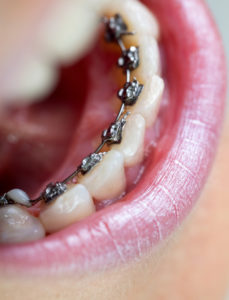
How Are Lingual Braces Different?
Lingual braces are similar to traditional metal braces. Many people don’t aesthetically like the look of metal braces, but they love their final straight smile. Metal braces are the strongest and are highly effective for achieving a beautiful smile. What can patients do if they want a straight smile but they don’t want braces front and center? Put that metal on the inside of the mouth between the teeth and the tongue!
Lingual braces are metal braces just like the traditional version, except that they are on the tongue-side of your teeth. However, there isn’t as much room on the back of your teeth like there is on the front of your teeth. If you notice, there is also a bit of a curve to the back of some of your teeth. That bracket-and-wire design can’t be exactly like the traditional version, but the design can be similar.
Using the same idea as traditional metal braces, you can achieve the same results as traditional braces, only with a hidden treatment apparatus on the tongue-side of your teeth. Patients that choose this option have impressions made of their mouth that focus on the backs of their teeth. After those impressions are sent to a special lab, metal backings for the teeth are made that are then bonded to the back of your teeth. They are almost like metal coverings for the entire tooth back, and often are silver or gold in color. These metal coverings also have small metal brackets and wires that discreetly correct bite and alignment issues over time. The concept is similar, but the design is tweaked to give lingual braces the same stability as traditional metal ones.
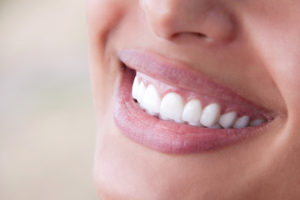
The Invention of Lingual Braces
- The push for hidden braces first started in the 70s with celebrities and public figures that wanted straighter teeth without visible metal braces.
- Craven Kurz and Jim Mulick were the first to develop prototypes for these braces in 1975. Craven Kurz was an orthodontist who later founded the American Lingual Orthodontic Association. Jim Mulick was the man Kurz partnered with from the UCLA School of Dentistry.
- The first prototypes of lingual braces led to tongue irritation and bracket breaks, which were resolved by inventing an inclined plane for these braces.
- Lingual braces are usually made of stainless steel, but they can also be made out of titanium.
- Craven Kurz applied for a patent in 1976 and the first lingual braces were produced in 1979. Ormco was the company Kurz partnered with that eventually created 7 different generations of lingual models until the current model.
- Each model involved changes to the orthodontic appliance including the additions of hooks and crannies, anterior and molar brackets and hooks, inclined planes, torque values, transpalatal bar hooks and a heart-shaped inclined plane.
- There are various designs of lingual braces that will vary based on how they look and how they are attached to the teeth. We use the “Incognito” style, but you may also hear types such as “iBraces”, “In-Ovation”, “STb Light Lingual System” and “Suresmile Lingual QT”.
How Do You Benefit?
Getting braces at all is a major step in the right direction if you want to be successful. Studies show that people who straighten their teeth often feel more confident in themselves, and their actions become more confident. Due to social, economic or aesthetic concerns, many patients may have the desire to straighten their teeth, but they don’t want to have metal braces on their teeth. For adults with careers or active social lives, they may view traditional metal braces as something only children and teens have.
However, at least 1/4th of patients with braces are adults. You simply may not see those braces because they have invisible braces like lingual braces. Lingual braces can achieve the same effect as regular metal braces without being seen. For a career setting, you can keep your white smile as it slowly becomes straighter overtime. For athletes, there isn’t a worry about dental injuries, as brackets and wires won’t cut up the cheeks or gums. Those who play wind instruments will find that lingual braces are much easier to play with than traditional braces. You get both the aesthetic appeal with sturdy straightening power with lingual braces. If you would like your free consultation, call Belmar Orthodontics today at (303) 225-9016!
Get Your Braces in Time for Back-to-School

School is just around the corner and it’s time to prepare your peers for your beautiful smile. Braces not only help straighten your teeth, but they can also improve your speech, your appearance and–most importantly–your confidence! New technology gives you more options for adding a little fashion flare to your smile or straightening your teeth discreetly. Learn about all of your amazing options for braces today.
Back-To-School Success
Summer is almost over and it’s back to school time. Is your smile ready? A lot can happen over the summer and each year brings new exciting changes. Getting a straighter, more beautiful smile is something you don’t want to be without as a new year starts off. Did you know that kids with straighter teeth tend to feel more confident in school and around their peers? That confidence can help them get better grades, make more friends, and be more willing to try new opportunities. Every child and teenager alike wants to shine in their own way. You can do that and receive more confidence by getting your braces just in time for school.
In the past, many adolescents saw braces as embarrassing or unattractive. However, studies show that children and teens are receiving braces in much larger numbers than they did in the past. Now, instead of being embarrassing, braces are seen as a luxury for many families and individuals. In times of recession, families even go without necessities to make sure their children receive braces. Braces truly are worth having because of how beneficial they are for boosting self-esteem, confidence and how you’re perceived socially. Investing in them is a great way to help a child as they start off school once more.
Options for Your Braces
We love providing options for our patients at Belmar Orthodontics! Our most popular option for braces for children and teens alike are our traditional metal braces. However, there are other options we provide as well:
- Traditional Metal Braces – This is our most economical option. Our patients love the colorful bands that they can customize their braces with. Each patient can choose a certain color they love every appointment or even do a rainbow of color if they so choose.
- Incognito Lingual Braces – This option is very similar to traditional metal braces, however the braces are worn on the tongue-side of your teeth. We make an impression of your teeth and then custom-make braces that fit the inside of your teeth perfectly. You can straighten your teeth with the perfect hidden apparatus.
- Clear Ceramic Braces – We can provide ceramic braces for our patients. These braces are similar to traditional metal braces, but they are made from ceramic material. The braces blend in with your teeth perfectly as the brackets and even the wires can be made white. Ceramic braces can also decrease demineralization that can happen with metal sometimes.
- Invisalign Teen – This is a version of Invisalign transparent aligners designed with the needs of teenagers in mind. These custom-fit aligners can correct smiles and unevenly-spaced teeth while allowing patients to continue eating, drinking, and cleaning their teeth with ease.
Cleaning At Home
Your braces are something new and exciting. However, they must have proper care to truly work wonders. Brush and floss your teeth often. We recommend brushing and flossing at least twice daily. However, with braces you may want to brush the teeth more than twice a day. After each meal would be best, as food can become trapped in the brackets very easily, where it will then sit on the teeth. Plaque is a sticky, acidic substance that you want to avoid. Plaque is made from the sugars in the food you eat that mix with the bacteria in your mouth. When food is left on the teeth, that plaque can form and begin to erode your teeth.
Not brushing and flossing enough can cause erosion and demineralization that will be obvious once the braces come off. Use special flossers to get in between the teeth sufficiently. Take care of your teeth so that your smile is beautiful and straight without blemishes when your braces come off!
Tips for Success At School
Your braces are easier to manage when you’re prepared. At school, take a mouthguard with you to gym class. You can get injured with braces when playing sports, especially contact sports. A mouthguard will help protect you and your mouth from injury. Be careful what you eat as well. Some foods can damage or break your braces and other foods can get tremendously stuck in the brackets. Some foods to avoid are anything hard, gooey, crunchy or sticky. This includes food items such as gummy bears, fruit snacks, hard candies, chips of any kind, hard vegetables, and nuts. If you really want a food (such as hard fruits and veggies), make sure to cut them up into bite-size pieces. Biting into foods can lodge them into the braces, so be careful with this.
We also have braces kits you can have or tips to make one yourself. Take a kit with you to school that has the cleaning essentials you need: mirror, toothbrush, toothpaste, floss and flossers, wax for pokey wires, etc. If you need a quick cleaning or a quick fix for a wire, you’ll be set!
Your Free Consultation
There never was a better time to straighten your smile! Braces can provide your child the boost of confidence they need to start of the school year right. If you want to schedule your child’s appointment, call our Belmar Orthodontics office today at (303) 225-9016!
Parts of Braces and Their Importance
What role does each part of braces play? The brackets, bands, wires and even our oral health guidelines all play a vital role to the health of your teeth and the success of your teeth straightening. Braces have been perfected over the years to provide you various options for teeth straightening through traditional metal braces, lingual braces, ceramic clear braces, Invisalign and more. These options weren’t available in years past, and each option has been perfected to provide you quick and efficient teeth straightening. Find out why each part of braces is important and what role each piece plays when it comes to your oral health.
Parts of Braces
Traditional metal braces have been around for decades. We still offer these braces because frankly, they work so well. Metal braces are also the most popular orthodontic option because they work to straighten your teeth the quickest and are the most cost-effective orthodontic option you can find. The metal we use is strong and sturdy. Metal braces are made from stainless steel, but can also be used in combination with titanium. There are three main parts of braces: the brackets, the wire, and the ligature elastics that go around the brackets:
- Brackets – These are the small metal pieces that are bonded to each tooth center using special glue. This glue ensures that the brackets stick to your teeth. The glue is gentle enough that it can be removed once your time with braces has finished. Brackets are made of stainless steel but also can be made white (tooth colored) or clear. These brackets hold the archwire for the teeth.
- Wire – This wire is actually known as the “archwire”. It is the metal wire that connects all of the brackets together in your mouth. You will have one archwire that is along the upper teeth and one that is along the lower teeth. This wire curves around the teeth and puts pressure on the teeth so that they come into proper alignment in the mouth. This is the main player that works to move your teeth in the right direction.
- Ligature Elastics – These are the rubber bands that attach the archwire to the brackets on each tooth. Without these ligature elastics, the archwire would not be sturdy and couldn’t do its job.
Additional Parts of Braces
There are more than just these three parts of braces.
- Headgear – This is an external appliance used in orthodontic care to help realign the face and jaw during your time with braces. There is retraction headgear and protraction headgear. Retraction headgear is an appliance used to retract the upper jaw. Protraction headgear moves the upper jaw forward and into proper alignment with the lower jaw. Headgear will consists of a single strap that fits around your neck and attaches to the front of your teeth. There is a second type of headgear that attaches to your braces, but the headgear has straps that fit over your head and neck. Not all patients will receive headgear unless it is really needed.
- Springs – Many braces have springs to help push and pull the teeth in the right direction. These springs generally attach to the arch wires and are located between the brackets of each tooth. The purpose of the springs are to open up or close up spaces between the teeth as they shift.
- Elastic Rubber Bands – Some patients need the additional shifting power of rubber bands to help the teeth move into place on schedule. These bands are attached to the brackets and will go from a lower tooth bracket to an upper tooth bracket. You will receive these rubber bands at your checkup and instruction for attaching your elastic bands at home until your next checkup.
Different Types of Braces
There are more than types of braces than just traditional metal ones. At Belmar Orthodontics we offer the following additional braces options:
- Incognito Lingual Braces – These braces quite literally go “incognito” as they are hidden inside your mouth. You will receive the same type of treatment as traditional metal braces. However, lingual braces are a hidden treatment apparatus on the tongue-side of your teeth. The brackets and metal are attached here and straighten your teeth without anyone else knowing.
- Invisalign – Invisalign is one of the stealthiest forms of teeth straightening. It is a series of transparent aligners customized to your teeth. You will change these aligners every 1-2 weeks until your smile is straight. They are easy to clean, easy to remove for eating and sports, and are virtually invisible in the mouth.
- Clear Ceramic Braces – Instead of metal, these braces are made from strong ceramic. They appear very similar to metal braces but are colored to match the shade of your teeth so they blend into the mouth. Even the archwires can be made white.
- Retainers – You will receive a retainer after your orthodontic braces treatment has been completed. Wearing your customized retainer is vital to maintaining a straight smile, as the teeth can quickly shift out of place. The first month is the most crucial as this is the time when your teeth will shift the most if a retainer isn’t worn.
Your Free Consultation
Keeping the parts of braces clean will greatly enhance your experience, so following our guidelines will help you find success with your orthodontic care. Proper braces appliances and all their parts will ensure that your teeth shift into perfect alignment in the least amount of time. If you would like to learn more about braces or need to schedule your appointment, call our Belmar Orthodontics office today at (303) 225-9016!
Straightening through Temporary Anchorage Devices
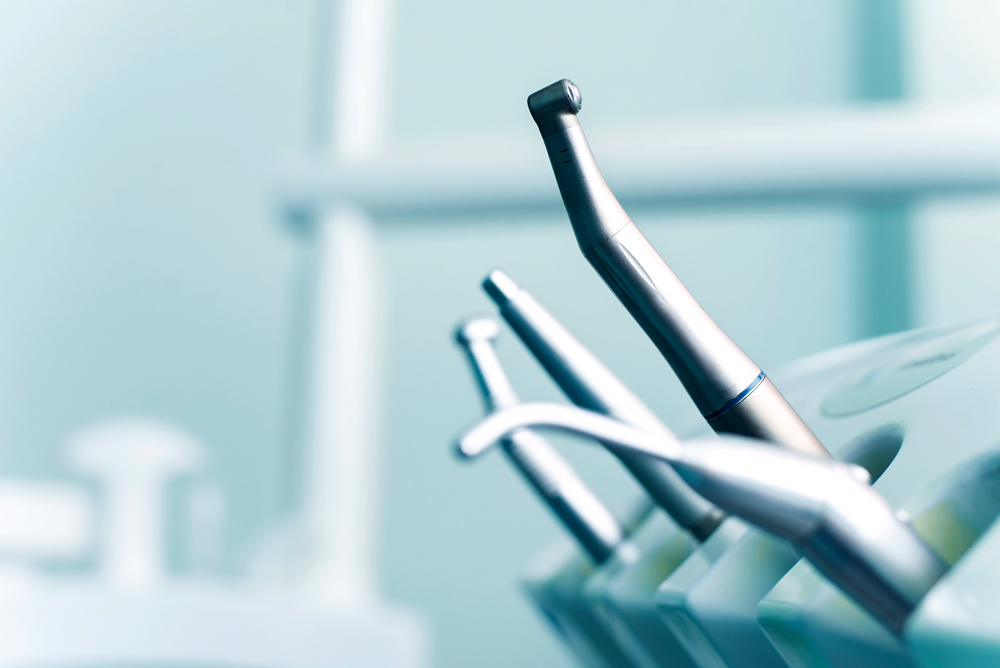
What are temporary anchorage devices and what can they do for you? Not all of our patients receive TADs for their teeth, but the ones that do greatly benefit from their straightening power. TADS are small titanium screws we use to help our our patients move their teeth. We place the screw in the gum and jaw bone and it acts as an anchor point for the teeth. We specialize in many methods of teeth straightening such as traditional braces, Invisalign, lingual braces and more, but also employ the use of TADs as needed to give our patients an exceptional smile. They can even aid in creating quicker tooth movement in our patients to achieve the desired straightening effect that is needed. Learn more about all of our straightening methods and which one is right for you. If you need TADs, you can trust in our expertise and finesse with giving you a straightening experience you will enjoy at Belmar Orthodontics.
The Advancement of Orthodontics
Orthodontics has come a long way from the crude methods of straightening practiced centuries ago. Extensive headgear and wires were used to straighten the teeth in the past. We benefit today from advanced technology that allows us many options when it comes to straightening the teeth, even discrete options. Temporary anchorage devices (TADs) are one of the methods we employ at Belmar Orthodontics when it’s in the best interest of the patient. Temporary anchorage devices work with braces to get your teeth straighter, faster. How do they work though?
Tidbits About Temporary Anchorage Devices
Temporary anchorage devices help shift the teeth into a straighter position when braces can’t do the job on their own. Braces are usually sufficient for most patients, but we want all of our patients to benefit from amazing, straight smiles and because of this we use TADs to get them all the way there. TADs consist of small, titanium mini-screws called “mini-implants” or “micro-implants”. These implants are fixed objects that braces use to push, pull, lift or intrude teeth while straightening. Just think of them as anchor points that are amazing tools for braces to get your teeth straighter. Once inserted, TADs do not move, but Dr. Hardy is able to use them to move the teeth in directions and distances that were not previously possible.
How Do They Work?
Temporary anchorage devices are installed quite easy, much like other orthodontic options. You have to be a good candidate for TADs to receive them. This means free of gum disease and you need a strong jaw. Your gum tissue and jaw area will be numbed much like they are numbed at a dental office before a procedure. Then Dr. Hardy will insert the tiny metal screws in areas that will help your teeth to move the most. The insertion process will be completely painless. Adjustment to TADs might take a day or two. The adjustment process should be no different than adjusting to metal braces. Adjusting to any type of straightening device takes time. We will remove the TADs once your teeth have moved into proper place. It’s literally that easy.
Traditional Straightening Options
We have many options for straightening instead of solely relying on traditional metal braces. We’ll still include metal braces on our list though:
- Traditional Braces – These are the standard metal braces that we all know and love. The great thing about “traditional” braces is that they are traditional for a reason. They are strong and highly effective with moving the teeth. Most of our patients get to dress up their brackets with a variety of colors at each visit too. This is usually the most cost-effective option when it comes to straightening the teeth.
- Ceramic Braces – These are basically your traditional metal braces, except for the fact that they can be made white to match the color of your teeth. The wires and brackets are both made white so they are virtually unnoticeable in your mouth. Ceramic braces are made of ceramic material. Ceramic is harder to stain and easier to clean than metal.
Discreet Straightening Options
Want a straight smile without others knowing? Try lingual braces or Invisalign!
- Lingual Braces – Take a step up from traditional and ceramic braces with lingual braces. These braces are called “incognito” braces because they do just that—go incognito! We customize lingual braces to the shape of your teeth. We then attach them behind the teeth instead of in front. You’ll receive all the strength and functionality of metal braces without the visibility.
- Invisalign – Invisalign is perhaps the most discreet form of teeth straightening. These transparent, removable aligners are perfect for teens and adults who want a straighter smile and don’t have bite problems. You will receive customizable aligners that change every few weeks so that the teeth are constantly falling into a straighter position. Oral care is easier, you can remove them at your leisure, and you will come out in the end with a straight smile—which is what we all want!
If you ever need to have TADs, just know that you are going to be having a powerful straightening experience that usually takes less time than it otherwise would to receive your beautiful, straight smile. We could all benefit from a little more time, right? To learn more about all your straightening options, call our Belmar Orthodontics office today at (303) 225-9016!
Straighten Your Teeth Invisibly with Lingual Braces
Incognito lingual braces straighten your smile invisibly. Hidden behind your teeth, lingual braces give you the treatment results you want without the cosmetic distraction that traditional braces can cause. Especially popular with our working professionals, lingual braces won’t interrupt your lifestyle, but will deliver the optimum oral health results you need and desire.
Amazing 3M Technology
Incognito braces, from 3M Technologies, offer what many have been hoping orthodontic technology would achieve for years–braces that work behind your teeth, out of sight. With lingual braces, you don’t have to choose between having the orthodontic treatment you need or putting it off due to aesthetic concerns. This obvious cosmetic advantage has been propelling the Incognito Lingual Braces System to the forefront of popular orthodontic options in the industry. Lingual (tongue-side) braces are bonded behind the teeth rather than in front so they are hidden when you talk and smile. Lingual braces offer you the same effective results as traditional braces but with a nearly undetectable appearance during the treatment process.
Lingual Braces Not Offered Everywhere – We Have the Expertise You Need!
Not all orthodontists offer lingual braces because training and technical expertise are needed to be able to provide you with the effective results you want. The dentists at Belmar Orthodontics have the expertise, training and experience needed to offer you this technologically-advanced treatment option. We want all our patients to be comfortable with their orthodontic treatment and not shy away from necessary improvements with their smile or mouth health because they think traditional metal braces are their only option. The American Lingual Association of Orthodontists represents orthodontists dedicated to using the lingual braces procedure.
The Popularity of Incognito Lingual Braces
Our patients love Incognito™ Lingual Braces because they are invisible when they smile allowing them to share their beautiful smiles with confidence during treatment. While Invisalign offers similar cosmetic benefits, Incognito™ Lingual Braces are always on and always working toward giving you the results you need and want. Unlike Invisalign, you don’t have clear aligners that you have to remove and clean every time you eat. And, you don’t have to worry that you will misplace or lose them. If you are an athlete, a musician who plays a wind instrument, or a patient who is not a candidate for Invisalign®, but wish to have a more discreet orthodontic treatment option, Incognito™ Lingual Braces are for you.
Can Anyone Choose Lingual Braces?
After an initial consultation and evaluation at Belmar Orthodontics, Dr. Hardy can determine if lingual braces are the best method for straightening your teeth. Once Dr. Hardy has determined that you are an ideal candidate for lingual braces, he will take impressions of your teeth that are then sent to a lab for custom-made brackets and wires. The braces will then be bonded behind your teeth for effective but discreet treatment. Periodic office visits give Dr. Hardy an opportunity to monitor your progress and make any necessary adjustments to optimize your final results.
Call for a Lingual Braces Consultation
Don’t delay orthodontic treatment because you are worried about how braces will impact your current smile. Incognito™ Lingual Braces give you a discreet option you can trust. Call our Lakewood office today at 303.225.9016 to make an appointment.
The Power of Incognito Braces
Incognito orthodontic braces represent the newest advancements in smile transformations with orthodontic care. The Incognito orthodontic brackets system is attached to the lingual side of your teeth (tongue side) so they are virtually invisible when you smile. This state-of-the-art technology works behind the scenes to bring you a customized smile without drawing attention to brackets and wires–all that people will see is your beautiful smile! Incognito braces work more quickly than traditional braces to straighten your teeth and require less adjustments since the bracket system is designed specifically for the shape of your teeth. All of these great results with the added benefits from great aesthetics–Incognito braces will revolutionize orthodontics.
Incognito Braces: Working Behind the Scenes
Working professionals and adult crowds are excited about their orthodontic treatment options. In the past, many have resisted the need to address serious bite and smile issues because they just didn’t feel like they could interrupt their lives with the wires and brackets that accompany traditional braces. But now, Incognito braces are giving them options they never thought were possible. Incognito braces, from 3M Technologies, offer what many have been hoping medical technology would achieve for years–braces that work behind your teeth, out of sight. This obvious cosmetic advantage has been propelling the Incognito Lingual Braces System to the forefront of popular orthodontic options in the industry. Lingual (tongue-side) braces are bonded behind the teeth rather than in front so they are hidden when you talk and smile. Lingual braces offer you the same effective results as traditional braces but with a nearly undetectable appearance during the treatment process.
Customized for You
Unlike traditional metal braces, Incognito braces are 100% percent customized for you. This advantage means you will find superior comfort and maximum results. The high-tech engineering behind this product uses a bracket and wires system that is targeted to your unique needs. And, unlike the other popular invisible braces alternative–Invisalign–they are always on, always working. There are no aligners to have to remove or maintain. The close contouring of lingual braces to your teeth also means that it is more difficult for food particles to get trapped behind your braces keeping your teeth healthier during the process.
Am I a Candidate for Incognito Braces?
The great thing about lingual Braces (Incognito – Hidden Braces) is they are suitable for patients of any age. They offer you the amazing benefit of achieving a great smile, and correcting bite issues, without interfering with your appearance. Anyone who is in need of orthodontic care, but cannot compromise their appearance during treatment, will find lingual braces to be a great fit. You will be able to actually see the improvements to your smile, since your teeth are not hidden by braces in the front. Athletes, musicians who play wind instruments, media professionals and patients who are not candidates for Invisalign®, but wish to attain more discreet orthodontic treatment, may prefer this option of care.
Common Questions About Incognito Braces (Lingual Braces)
The three most common questions we receive about Incognito braces are: 1) do they hurt; 2) will they affect my speech; and 3) are they hard to take care of? Any procedure to move and straighten your teeth will require some tolerance to teeth tenderness as they shift, but the actual process of receiving the braces is painless for most people. You can expect a slight adjustment period as your tongue and tissues get used to having the appliance in your mouth. Wax can help ease some of the discomfort as your mouth adjusts. As far as speech concerns go, most patients adjust to speaking with lingual braces within two weeks. Slowing your speech as you become comfortable with the apparatus will help. The extra effort it takes to adjust to lingual braces (or any braces for that matter) will be worth the results! Incognito braces will not change the difficulty of your oral hygiene routine, but having them present means you do need to be committed to regular and thorough oral hygiene habits. Some patients have found that proxy brushes make cleaning their teeth easy, especially when they are out and about. Others really enjoy the power of electric toothbrushes and water flossers for a thorough cleaning. But, more than anything, you just need to commit to regular brushing and flossing during orthodontic treatment.
Finding a Lingual Braces Provider
Dr. Hardy at Belmar Orthodontics has the expertise, training and experience needed to offer you this technologically-advanced treatment option. He wants all his patients to be comfortable with their orthodontic treatment and not shy away from desired (and necessary) improvements with their smile or mouth health because they think traditional metal braces are their only option.
Schedule a Consultation to Learn More
The best way to find out if you are a candidate for lingual braces and to learn more is to schedule an appointment for an in-office consultation. If you have more questions about Incognito braces or would like to make an appointment to learn more about your options, please contact our office today at 303.225.9016. We are excited to meet you and help you reach your smile goals!
